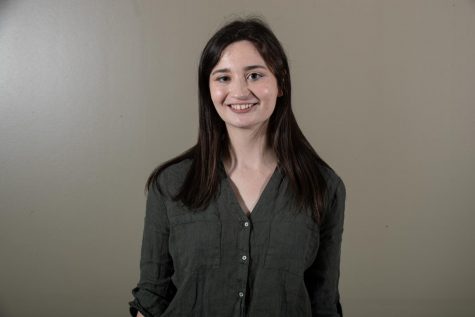Finding therapy in a few lines
With a few strokes, UI senior Josephine Beddor, a visual artist, shows how minimalist art can be therapeutic.
University of Iowa student Josephine Beddor poses for a portrait on Tuesday, April 30th, 2019.
May 1, 2019
“Le futur est entre nos mains.”
Below the phrase depicts a melting candle held by a white hand, with the painting intertwining Josephine Beddor’s ancestry and strive for healing.
Influenced by her French heritage, Beddor spent some time in Paris at a young age because of her mother’s work. She was quickly enamored with the lifestyle and culture.
“It felt like I found my people,” she said, looking back at her time in France. “[The place] is very laid-back and natural, so I really identified with that. [My art] is just me giving homage to that, but giving my own spin on it.”
Beddor grew up with dyslexia, leaving it difficult for her to read words. Developing as a visual learner, she said, frequently drawing her notebook allowed her to process what she was learning in class.
She didn’t begin to publicly show her work until a few years ago, when she became involved with Collaboration Of All The Arts, a movement started by her partner that encourages collaboration among creators.
While creating her art, Beddor describes the process as a highly emotional journey, allowing her to find healing through the work.
“In every single piece, I know exactly what I was going through and what I was thinking in that moment,” she said. “It’s good markers to track my growth, in a way. There’s something really therapeutic about losing yourself in something and letting it become whatever it needs to be.”
Beddor draws inspiration from abstract art figures, particularly from Frida Kahlo, because of her use of bright colors and eerie content.
Women are a prominent subject in Beddor’s work, with a woman’s face appearing in a embroidery or a woman’s naked backside in a painting.
The piece that has the most meaning to her is a painting titled Ethel, an image portraying the face of a young woman. Originally starting off as a self-portrait, the woman eventually became a completely new person who Beddor allowed others to ascribe a personality to.
Following graduation this spring, she will move to Oregon to live with her sister, who recently bought a café. From there, she will help curate art for the business.
Although she plans to make a serious living off her art, creating work that people can identify with is what she truly cares about.
“That has been such a healing thing for me throughout my life of art, being the tool of healing,” she said. “If I can be that for other people, that’d be so worth it.”















